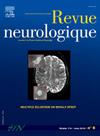French guidelines for the diagnosis and management of MOG antibody-associated disease
IF 2.3
4区 医学
Q2 CLINICAL NEUROLOGY
引用次数: 0
Abstract
MOG antibody-associated disease (MOGAD) is a new entity within the spectrum of autoimmune inflammatory diseases of the central nervous system. It is distinct from multiple sclerosis (MS) and neuromyelitis optica spectrum disorder (NMOSD). Although they share certain clinical characteristics, these 3 diseases differ in terms of their pathophysiology, disease course and response to treatment. MOGAD is a rare disease affecting both adults and children, with a higher frequency in the latter. The clinical presentation of MOGAD varies depending on age: in children under the age of 10, presentations of acute disseminated encephalomyelitis (ADEM) are frequently described, whereas in children over the age of 10 and in adults, unilateral or bilateral optic neuritis or acute myelitis is more often observed. Other, rarer presentations have also been reported, including encephalitic presentations with seizures. Radiologic findings can sometimes help guide the diagnosis: extensive anterior optic nerve involvement, perineuritis, extensive lesions of the spinal cord with involvement of the conus medullaris, and involvement of the pons, for example. Diagnosis is confirmed by measuring anti-MOG antibodies in the serum. In case of diagnostic doubt, the result must be confirmed in a reference laboratory (currently available in Lyon and Le Kremlin Bicêtre in France). The disease course is usually monophasic in children, but relapses are possible. In adults, the frequency of relapses seems higher than in children, estimated at more than 40% after 5 years. Visual, bladder/sphincter, cognitive and, to a lesser extent, motor sequelae may occur, but much less frequently than in NMOSD. In children and adults, attacks are treated with high-dose IV corticosteroids, which are often very effective, followed by an oral taper. In certain situations, long-term immunoactive therapy may be proposed, particularly when a relapse occurs, after discussion with a reference or expert center for Inflammatory diseases of the central nervous system. Long-term follow-up is proposed at the reference/expert center at least once a year. In between these appointments, follow-up with the referring pediatric neurologist, pediatrician, treating physician or referring neurologist is carried out every 6 months. It is important to check for the occurrence of a new attack and the onset of complications but also, in the case of long-term therapy, adherence to and tolerance of the treatment. Multidisciplinary management is essential and involves a variety of healthcare professionals (neurologist or pediatric neurologist, ophthalmologist, physiatrist, physiotherapist, speech therapist, occupational therapist, psychologist and social worker).
法国MOG抗体相关疾病诊断和管理指南。
MOG抗体相关疾病(MOGAD)是一种新型的中枢神经系统自身免疫性炎症性疾病。它不同于多发性硬化症(MS)和视神经脊髓炎光谱障碍(NMOSD)。虽然它们具有一定的临床特征,但这三种疾病在病理生理、病程和治疗反应方面存在差异。MOGAD是一种既影响成人也影响儿童的罕见疾病,后者发病率更高。MOGAD的临床表现因年龄而异:在10岁以下的儿童中,经常出现急性播散性脑脊髓炎(ADEM)的表现,而在10岁以上的儿童和成人中,更常观察到单侧或双侧视神经炎或急性脊髓炎。其他罕见的表现也有报道,包括癫痫发作的脑病表现。放射学表现有时可以帮助指导诊断:例如,广泛的前视神经受累,神经会阴炎,脊髓广泛病变累及髓圆锥,累及脑桥。通过测定血清中的抗mog抗体来确诊。如果诊断有疑问,结果必须在参考实验室确认(目前在里昂和法国的克林姆林宫Bicêtre)。儿童的病程通常为单相,但也有可能复发。在成人中,复发的频率似乎高于儿童,估计在5年后超过40%。视觉、膀胱/括约肌、认知和(在较小程度上)运动后遗症可能发生,但比NMOSD少得多。在儿童和成人中,发作用高剂量静脉注射皮质类固醇治疗,这通常非常有效,然后口服逐渐减少。在某些情况下,可以建议长期免疫活性治疗,特别是当复发时,在与参考或中枢神经系统炎症性疾病专家中心讨论后。建议每年至少在参考/专家中心进行一次长期随访。在这些预约之间,每6个月与转诊儿科神经科医生、儿科医生、治疗医生或转诊神经科医生进行一次随访。重要的是检查新发作的发生和并发症的发生,但在长期治疗的情况下,还要检查治疗的依从性和耐受性。多学科管理是必不可少的,涉及各种医疗保健专业人员(神经科医生或儿科神经科医生,眼科医生,物理医生,物理治疗师,语言治疗师,职业治疗师,心理学家和社会工作者)。
本文章由计算机程序翻译,如有差异,请以英文原文为准。
求助全文
约1分钟内获得全文
求助全文
来源期刊

Revue neurologique
医学-临床神经学
CiteScore
4.80
自引率
0.00%
发文量
598
审稿时长
55 days
期刊介绍:
The first issue of the Revue Neurologique, featuring an original article by Jean-Martin Charcot, was published on February 28th, 1893. Six years later, the French Society of Neurology (SFN) adopted this journal as its official publication in the year of its foundation, 1899.
The Revue Neurologique was published throughout the 20th century without interruption and is indexed in all international databases (including Current Contents, Pubmed, Scopus). Ten annual issues provide original peer-reviewed clinical and research articles, and review articles giving up-to-date insights in all areas of neurology. The Revue Neurologique also publishes guidelines and recommendations.
The Revue Neurologique publishes original articles, brief reports, general reviews, editorials, and letters to the editor as well as correspondence concerning articles previously published in the journal in the correspondence column.
 求助内容:
求助内容: 应助结果提醒方式:
应助结果提醒方式:


